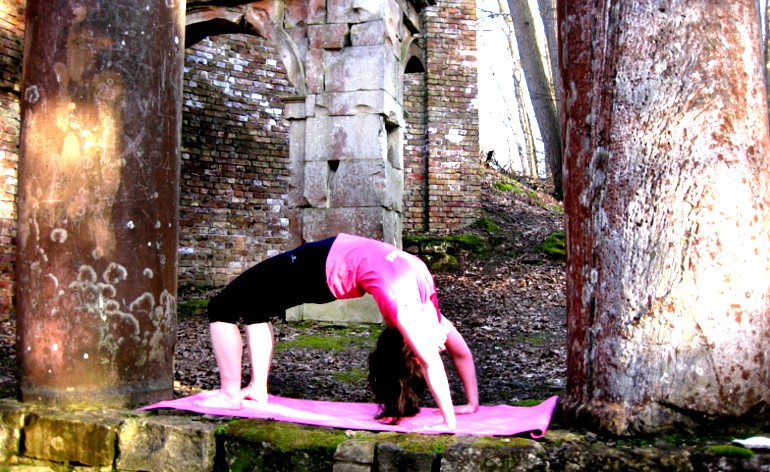Cristina Freniche is a trained YogaBellies teacher who offers classes in Guildford and shall be doing some blogging about fitness and health for you and your baby; this week giving tips on the Wheel Pose. Christina is a young professional living in Guildford, although she is originally from Spain. Her passion is for all things pregnancy and baby related and partnered with her love for Yoga, it has culminated in her taking YogaBellies teacher training. YogaBellies offer authentic classes, therapies and workshops for women and children at every stage of their lives including pregnancy and birth; for post-partum mum and baby and now also, yoga for children. They offer yoga for women from menstruation to post-menopausal.
This is a pose that I’ve recently mastered. Or shall I say re-mastered? I’m pretty sure I was able to get into it (and even crawl around) when I was a kid. Or maybe I should say I lost my fear and finally dared getting into it.
In any case, let’s have a look at this advanced pose, which many people can identify as typically ‘yogic’, although my definition of yogic has more to do with what you do with your mind than with your body. Please do not attempt this pose until you can comfortably hold bridge pose (Setu Bandhasana) for at least 10 deep breaths. Not recommended in pregnancy or in the postpartum period.
Benefits
- Expands your chest and shoulders.
- Stretches your hip flexors, core and wrists.
- Strengthens your arms and the muscles that control your shoulder blades.
- Strengthens your buttocks and the back of your thighs.
- Strengthens your lower back.
- Relieves some forms of low back pain.
- Therapeutic for asthma, opening the accessory muscles of breathing.
- Traditionally thought to stimulate the thyroid and pituitary glands, increase energy counteracting depression and aid in infertility.
Contraindications and Cautions
- Back injury, or low back pain aggravated by extension (bending backward).
- Carpal tunnel syndrome or tendonitis of the wrist.
- Diarrhea.
- Headache.
- Heart problems, high or low blood pressure.
- Shoulder impingement.
Instructions
- Lie on your back with knees bent, soles of your feet on the floor, close to your sitting bones, feet hip width apart and parallel to the sides of the mat. Place your hands on the floor, shoulder distance apart, elbows bent, just above your shoulders. Fingers are spread wide, finger tips pointing towards your shoulders and forearms relatively perpendicular to the floor.
- Throughout the pose, the legs should remain parallel to each other and hip distance and the arms should be parallel to each other and shoulder distance. Shoulder blades should slide towards each other and down the back.
- Press evenly into your feet and lift your hips and lower back off the mat, coming into a bridge pose. Firm (but not harden) the buttocks. Take two or three breaths.
- Press into your palms evenly and lift your upper torso off the mat, bringing the crown of your head to lightly touch on the mat. Take two or three breaths.
- Press into your palms once again to straighten the arms and lift your head off the floor. Let the head hang, relaxing with gravity, or lift it slightly to look down at the floor. Breathe. Stay for as long as your body and your breath are comfortable.
- To come out of the pose, slowly begin to bend the arms and legs, tuck the chin towards the chest, and lower your spine to the mat, one vertebra at a time.
- Counteract the deep backbend by bringing the knees to the chest, hugging them and maybe rocking slowly from side to side.
Using props
- Tie a strap around your thighs, just above the knees, to keep the thighs hip width and parallel to each other.
- Place a block between the feet, with the bases of the big toes pressing the ends of the block, to keep them from turning out.
- Tie a strap around your upper arms, just above the elbow, to keep the arms shoulder width and parallel to each other.
- Use a block in between the thighs to keep them parallel and access your core muscles.
- Use blocks below the feet for tight hip flexors, or below the hands for tight shoulders. Make sure they are against a wall so you don’t slip!
With a partner
A partner can help you get into the Wheel Pose by standing with their feet close to your head, where your hands would be. You can then grab onto their ankles, and your partner can bend forward and help you lift your chest.
Cristina Freniche


